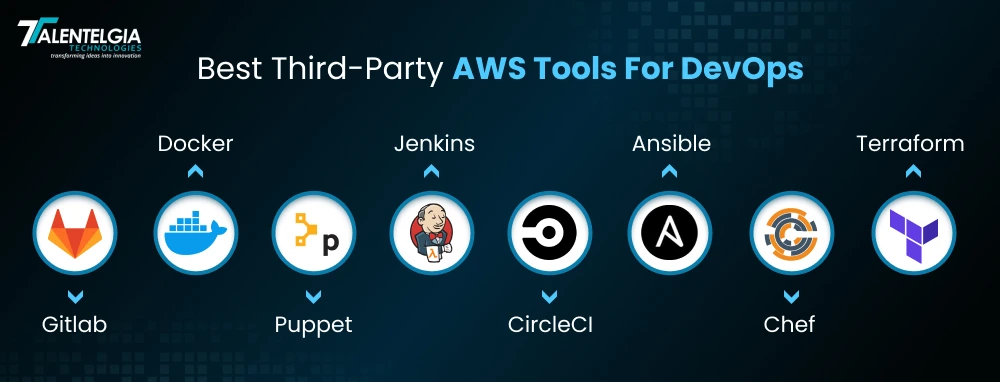Want to make your software development and deployment processes more efficient? Fast application development and smooth deployments are essential for modern businesses. AWS offers a suite of native tools that facilitate software delivery into the cloud environment, automate processes, and manage infrastructure. Organizations can build and innovate while reducing manual work and operational complexity using these tools. In this blog, we have covered the top 12 AWS DevOps tools along with their features, advantages, and use cases. If you’re looking to improve DevOps development services and create scalable cloud solutions, these tools will be essential for your journey. Let’s dive in!
What Are AWS DevOps Tools?
AWS DevOps tools are a variety of cloud-based services provided by Amazon Web Services (AWS) to assist in automating and streamlining the software development, testing, deployment, and monitoring processes. These tools enable businesses to adopt DevOps practices by bridging the collaboration gap between the development and operations teams by offering faster delivery of high-quality software.
AWS offers a multitude of services that make the DevOps lifecycle easier, from automating CI/CD pipelines and controlling Infrastructure as code (IaC) to monitoring apps and guaranteeing the safety of your software. AWS CodePipeline, AWS CodeBuild, AWS CodeDeploy, and AWS CloudFormation are some of the most commonly used AWS DevOps tools, each of them providing unique functionalities to improve the efficiency and scalability of applications.
However, adopting DevOps practices also comes with its own DevOps challenges and solutions, such as maintaining consistent environments, and managing infrastructure at scale. AWS tools like AWS CodePipeline, AWS CodeBuild, AWS CodeDeploy, and AWS CloudFormation provide unique functionalities. This helps address these challenges, improving the efficiency and scalability of applications.
Top Native AWS DevOps Tools
AWS offers a range of native DevOps tools that streamline application development, testing, and deployment. These tools integrate seamlessly with other AWS services, ensuring faster and more reliable software delivery. Let’s take a closer look at each of them.

1. AWS Code Pipeline
The AWS CodePipeline is a fully managed continuous delivery (CD) service that facilitates the steps required to release software. It allows you to model, visualize, and configure the different steps of your deployment pipeline and the underlying architecture, enabling faster and more reliable software delivery. Orchestrating the workflow: CodePipeline easily links code from a source to a build, and then on to test and deploy.
It also supports parallel execution, and custom and pre-built plugins, and enables defining the pipeline structures through a declarative JSON document. It works with common version control platforms like AWS CodeCommit, Amazon S3, Amazon ECR, and GitHub to seamlessly pull and deploy your code. It also supports running an array of unit tests and builds via CodeBuild, including deployment of changes to services such as CodeDeploy, Elastic Beanstalk, Amazon ECS, and Fargate. You can also invoke Lambda functions to perform custom actions at any point of the pipeline.
Use Cases of AWS CodePipeline
- Automating end-to-end application deployment with minimal manual intervention.
- Enabling seamless integration of CI/CD pipelines with AWS services and external repositories.
- Triggering custom functions or workflows using AWS Lambda for added flexibility.
Benefits of AWS CodePipeline
- Quicker Releases: Automates the release process, thus reducing time-to-market.
- Improved Reliability: Guarantees consistent deployments across environments
- Increased Flexibility: Enable any number of different integrations and custom plugins to meet specific needs.
2. AWS CodeBuild
AWS CodeBuild is a fully managed continuous integration (CI) service that removes the overhead of provisioning, scaling, and managing build servers. It automates the actions that involve compiling source code, running tests, and packaging software for deployment. CodeBuild only requires that you provide the location of your source code (i.e., your Git repository) and define your build settings, and CodeBuild handles the rest.
Some of its most powerful features include auto-building of code commits. CodeBuild supports a variety of build tools including Gradle, Apache Maven, and npm, and works easily with multiple programming languages. Moreover, as it is a serverless utility, it scales instantly so you no longer have to worry about how traffic impacts your builds.
Use Cases of AWS CodeBuild
- Automating builds for CI workflows (triggered by code changes).
- Building and testing applications are written in various programming languages.
- Deploying package software in a variety of AWS environments.
Benefits of AWS CodeBuild
- Scalability: Automatically scales according to workload and maintains performance.
- Flexibility: Multiple build tools and languages supported to meet a wide range of development demands.
- Cost Efficiency: With a pay-per-use pricing model, users only pay for the build time consumed.
3. AWS CodeCatalyst
A variety of deployment services offered by AWS Code Catalyst is an integrated DevOps service for software code and delivery that superseded AWS CodeStar in July 2024 with a more integrated environment for building, managing, testing, and deploying applications on AWS. Dev Environments are created automatically in Code Catalyst with pre-installed dependencies and project templates. This makes code storage and versioning easy and tracks changes in code files, as well as provides easy integration with popular repositories like GitHub and GitHub Actions. Developers can also launch their cloud environments directly from their favorite IDEs like IntelliJ IDEA, AWS Cloud9, and PyCharm from within Code Catalyst. AWS CodeWhisperer, an AI-based coding assistant that provides real-time code suggestions, also boosts productivity and minimizes coding errors.
Use Cases of AWS CodeCatalyst
- Building, testing, and deploying applications on AWS with effortless GitHub integration.
- One-click Manages multiple projects, branches, and repositories
- Using AI-generated code with CodeWhisperer for faster development.
Benefits of AWS CodeCatalyst
- More efficient: Thanks to automated environments and AI-assisted tools, the development process becomes faster.
- Repeat And Reuse: This can be used by other developers.
- Improved Collaboration: Smooth integrations for GitHub and GitHub Actions make working together easier.
4. AWS CodeDeploy
AWS CodeDeploy provides a variety of deployment services that easily interface with computing services like Amazon EC2 instances, AWS Lambda functions, Amazon ECS, and on-premises servers. It makes the deployment process easy and simple for various repositories like GitHub, BitBucket, and Amazon S3, and makes sure that the release is consistent every time without any errors. CodeDeploy supports In-place and Blue-Green deployments, which is a perfect solution for applications that need to minimize downtime when deployed. It also supports lifecycle hooks, allowing teams to define custom actions at various points in the deployment process, providing more control over complex workflows.
Use Cases of AWS CodeDeploy
- Deploying the applications over hybrid environments, such as cloud, and on-premise servers.
- Release of Software with blue-green deployments with the minimum downtime.
- Hewing application updates from multiple source code repositories.
Benefits of AWS CodeDeploy
- Easier Deployment: It helps to automate sophisticated deployments with minimal manual capabilities.
- Flexibility: Enables compatibility with cloud, on-premises, and hybrid environments.
- Fine-grained Control: Lifecycle hooks provide finer customization and control over specific stages of the deployment.
Best Third-Party AWS DevOps Tools
In addition to AWS’s native tools, several third-party tools enhance DevOps workflows by improving CI/CD pipelines, container management, and infrastructure automation. Below are the top tools that integrate seamlessly with AWS to boost efficiency and control.

1. Gitlab
GitLab is a powerful alternative to source code management repositories like git-based GitHub or BitBucket, as it is a full-featured DevSecOps platform. It also offers automated CI/CD pipelines, project management, and security compliance, making it an end-to-end DevOps platform. GitLab aims to improve collaboration and efficiency by integrating these capabilities into a single platform rather than using multiple tools (e.g. for CI/CD, project management, version control, etc.).
GitLab enables open, free, and private repositories — its free tier has unlimited private repositories, making GitLab a great choice for teams who want the extra layers of privacy without the costs. For organizations that need greater control over their data and security, GitLab also provides self-hosting options so that DevOps and FinOps teams can tailor their infrastructure management to meet their specific requirements.
Use Cases of Gitlab
- Source code management and CI/CD pipeline automation for efficient development workflows.
- Secure and Private Hosting for public and private repositories.
- Organize self-hosted environments for organizations wanting added control over data and infrastructure.
Benefits of Gitlab
- Manage source code and automate CI/CD pipelines to streamline development workflows.
- Hosting private and public repositories with enhanced security and privacy.
- Enabling self-hosted environments for organizations needing more control over data and infrastructure.
2. Docker
Docker is an essential part of the modern DevOps workflow and is especially common amongst teams that are deploying their containerized applications onto AWS. Being an indispensable and lightweight tool, it helps build, manage, and scale Docker containers to streamline application deployment. The complete set of components in the Docker ecosystem consists of Docker Engine, Docker Swarm, docker images, Dockerfile, Docker Hub, docker containers, and Docker Compose.
Docker allows you to scale up or down on demand, which helps to maintain operational costs while balanced against resource optimizations. Last but not least, Docker artfully integrates into CI/CD pipelines that allow developers to build, test, and manage containerized applications across multiple environments.
Use Cases of Docker
- Building and managing containerized applications in a lightweight, isolated environment.
- Orchestrating container deployments using Docker Swarm for scalability and efficiency.
- Integrating with CI/CD pipelines to automate application builds and testing.
Benefits of Docker
- Cost Management: With the AWS auto-scaling feature, it scales up or down as per the demand, thus saving costs for efficient resource management.
- Flexibility and Portability: Deploy in any container environment.
3. Puppet
Puppet is a popular configuration management tool used by DevOps teams to manage infrastructure as code and automate operations in the cloud, on-premises, and hybrid environments. The open-source edition of Puppet is a trusted infrastructure automation solution that enables users to discover resources quickly, provision new nodes efficiently, and orchestrate changes across clusters easily. Moreover, Puppet aids in software delivery by automating the application deployment process with minimum and rich workflows.
Puppet is a cross-platform configuration management tool, compatible with both Linux and Windows environments, and enables access to the extensive library of pre-built modules (over 7,000) available from Puppet Forge to build and extend functionality as per the needs of teams.
Use Cases of Puppet
- Infrastructure provisioning across cloud, on-prem, and hybrid environments
- Orchestrates and manages the configuration changes across all nodes.
- Promoting rapid software delivery and reliable application deployment.
Benefits of Puppet
- Infrastructure Automation: Automates the provisioning of nodes and management of resources reducing manual overhead.
- Flexible and Scalable: Natively supports Linux and Windows along with easy scaling across clusters.
- Large Module Library: Puppet Forge offers thousands of modules (more than 7,000) for greater customization and functionality.
4. Jenkins
Jenkins which is a well-known tool in the CI/CD space can organize the software development lifecycle by automating the build as well as test and deployments. It is a stand-alone, Java-based application that runs seamlessly on Windows, Linux, macOS, and other Unix-like operating systems. Jenkins has a web interface that makes it very easy to configure with error checks and built-in help. Having more than 2,000 plugins available, it integrates seamlessly with other tools in the CI/CD pipeline. Jenkins can also spread workloads across multiple machines for quicker, more efficient builds and deployments. Jenkins still be a top choice with a vast developer and community presence and regular updates to improve the tool to serve its users better.
Use Cases of Jenkins
- Automate CI/CD pipeline to efficiently build, test, and deploy applications
- Load balancing — Using more than one server to distribute workloads to improve scalability and performance.
- Expand features by letting a big community of plugins develop.
Benefits of Jenkins
- Reliability and Stability: Robust platform to manage critical application deployments.
- Flexibility: Integrates with many tools and platforms, offering 2000+ plugins
- Scalability: Efficiently distribute load and handle workloads across numerous machines.
5. CircleCI
CircleCI is a robust platform that helps DevOps teams automate complex workflows, optimize build processes, and deliver applications faster. It supports running jobs in the cloud or on-premises, across a range of environments, from Linux and Windows to macOS, making it a good fit for teams of all sizes. CircleCI enables you to define your entire CI/CD workflow in one YAML file, which allows for better version control and easier collaboration.
CircleCI provides the Insights Dashboard, one of the standout features, which provides real-time analytics on build performance. It helps teams detect possible bottlenecks at an early stage and close their pipelines for maximum efficiency. CircleCI also provides “orbs,” which are reusable bundles of configuration that simplify setup and auteur DevOps best practices across projects.
Use Cases of CircleCI
- Automating end-to-end CI/CD pipelines in diverse environments (cloud, on-premises, and multiple OS platforms).
- Streamlining project setup and maintaining DevOps best practices using orbs.
- Managing build performance while optimizing costs through customizable concurrency and resource settings.
Benefits of CircleCI
- Flexibility and Scalability: Multi-os support and seamless scaling for growing workloads.
- Better Pipeline Visibility: Real-time updates to track and optimize build performance
- Cost and Time Efficiency: Customizable resource settings help to achieve a balance between faster builds and reduced operational costs
6. Ansible
Ansible is a powerful IT automation tool that simplifies multi-tier deployments by modeling the entire IT infrastructure as a single deployment, eliminating the need to handle each component separately. It operates without the need for agents or custom security architectures, making it easy to manage remote systems efficiently. Ansible uses YAML (YAML Ain’t Markup Language), a human-readable, plain-English-like format to define automation tasks through playbooks. This simplicity, combined with its agentless architecture and modular design, makes Ansible a preferred choice for managing complex infrastructures across AWS, hybrid clouds, and on-premises environments.
Use Cases of Ansible
- Automating AWS infrastructure configuration and management
- Deploy applications across AWS environments efficiently.
- CI/CD Integration to support seamless app deployments.
Benefits of Ansible
- Simplified Management: Agentless architecture minimizes complexity and lowers operational overhead.
- By allowing the development of reusable modules and using YAML playbooks, there is increased flexibility to customize tasks.
- Automation of repetitive tasks saves time and minimizes manual work and errors.
7. Chef
Chef is used to manage configuration and automates managing the infrastructure using code rather than manual processes, allowing easy testing, deployment, and maintenance. It is client-server architecture-based and is cross-platform compatible (Windows, Ubuntu, CentOS, and Solaris). Chef can even integrate with cloud platforms, such as AWS, GCP, and OpenStack, making it perfect for an organization that employs large-scale systems. Chef automates configuration management to eliminate the possibility of human error, preventing a system from crashing or going down and making updates effortless.
Use Cases of Chef
- Implementation of AWS infrastructure provisioning and configuration automation
- Enforcement of compliance and security policies with policy-as-code principles
- Chef Automate and AWS OpsWorks for Application Deployment and Scaling
Benefits of Chef
- Better Compliance: Continuous compliance monitoring helps ensure systems comply with required security and regulatory standards.
- Infrastructure Consistency: Policy-as-code enables consistent infrastructure state across AWS environments.
- Reduced Complexity: AWS OpsWorks for Chef Automate takes away the complexity from the process of deploying and managing Chef servers.
8. Terraform
HashiCorp Terraform is an infrastructure-as-code (IaC) tool to provision cloud and on-premises resources by using a high-level configuration language that is both human-readable, and can be versioned, reused, and shared. Terraform is also a tool of the particular use case that allows obtaining and managing of infrastructure over its lifetime. Terraform is capable of managing both low- and high-level components as well as DNS entries and features of SaaS. It is very flexible and can be customized to suit a wide range of environments. It employs APIs using providers to create and provision resources on multiple platforms.
Use Cases of Terraform
- Provisioning and scaling of AWS infrastructure in an automated manner
- A single tool for managing hybrid and multi-cloud environments
- Managing infrastructure changes in a version control system for collaboration and traceability.
Benefits of Terraform
- Data and model management: Keeping track of datasets and trained models, their versions, and performance metrics.
- Multi-Cloud: One tool to manage AWS, Azure, GCP, and other environments.
- Faster deployment: Automation saves time in delivering the infrastructure.
Conclusion
Integrating AWS DevOps tools into your development lifecycle allows teams to automate, monitor, and manage their applications effectively. They streamline the collaboration process between development and operations teams, resulting in quicker delivery and better application performance.
Additionally, integrating third-party tools with AWS DevOps tools enhances DevOps workflows by introducing greater flexibility, scalability, and control over deployments and infrastructure management. By leveraging a combination of AWS native services and external solutions, organizations can reduce errors, minimize manual interventions, and accelerate the software delivery process.
Ultimately, adopting a well-integrated DevOps toolset allows businesses to maintain high-quality software, respond to changes quickly, and achieve long-term operational efficiency.


 Healthcare App Development Services
Healthcare App Development Services
 Real Estate Web Development Services
Real Estate Web Development Services
 E-Commerce App Development Services
E-Commerce App Development Services E-Commerce Web Development Services
E-Commerce Web Development Services Blockchain E-commerce Development Company
Blockchain E-commerce Development Company
 Fintech App Development Services
Fintech App Development Services Fintech Web Development
Fintech Web Development Blockchain Fintech Development Company
Blockchain Fintech Development Company
 E-Learning App Development Services
E-Learning App Development Services
 Restaurant App Development Company
Restaurant App Development Company
 Mobile Game Development Company
Mobile Game Development Company
 Travel App Development Company
Travel App Development Company
 Automotive Web Design
Automotive Web Design
 AI Traffic Management System
AI Traffic Management System
 AI Inventory Management Software
AI Inventory Management Software
 AI Software Development
AI Software Development  AI Development Company
AI Development Company  AI App Development Services
AI App Development Services  ChatGPT integration services
ChatGPT integration services  AI Integration Services
AI Integration Services  Generative AI Development Services
Generative AI Development Services  Natural Language Processing Company
Natural Language Processing Company Machine Learning Development
Machine Learning Development  Machine learning consulting services
Machine learning consulting services  Blockchain Development
Blockchain Development  Blockchain Software Development
Blockchain Software Development  Smart Contract Development Company
Smart Contract Development Company  NFT Marketplace Development Services
NFT Marketplace Development Services  Asset Tokenization Company
Asset Tokenization Company DeFi Wallet Development Company
DeFi Wallet Development Company Mobile App Development
Mobile App Development  IOS App Development
IOS App Development  Android App Development
Android App Development  Cross-Platform App Development
Cross-Platform App Development  Augmented Reality (AR) App Development
Augmented Reality (AR) App Development  Virtual Reality (VR) App Development
Virtual Reality (VR) App Development  Web App Development
Web App Development  SaaS App Development
SaaS App Development Flutter
Flutter  React Native
React Native  Swift (IOS)
Swift (IOS)  Kotlin (Android)
Kotlin (Android)  Mean Stack Development
Mean Stack Development  AngularJS Development
AngularJS Development  MongoDB Development
MongoDB Development  Nodejs Development
Nodejs Development  Database Development
Database Development Ruby on Rails Development
Ruby on Rails Development Expressjs Development
Expressjs Development  Full Stack Development
Full Stack Development  Web Development Services
Web Development Services  Laravel Development
Laravel Development  LAMP Development
LAMP Development  Custom PHP Development
Custom PHP Development  .Net Development
.Net Development  User Experience Design Services
User Experience Design Services  User Interface Design Services
User Interface Design Services  Automated Testing
Automated Testing  Manual Testing
Manual Testing  Digital Marketing Services
Digital Marketing Services 
 Ride-Sharing And Taxi Services
Ride-Sharing And Taxi Services Food Delivery Services
Food Delivery Services Grocery Delivery Services
Grocery Delivery Services Transportation And Logistics
Transportation And Logistics Car Wash App
Car Wash App Home Services App
Home Services App ERP Development Services
ERP Development Services CMS Development Services
CMS Development Services LMS Development
LMS Development CRM Development
CRM Development DevOps Development Services
DevOps Development Services AI Business Solutions
AI Business Solutions AI Cloud Solutions
AI Cloud Solutions AI Chatbot Development
AI Chatbot Development API Development
API Development Blockchain Product Development
Blockchain Product Development Cryptocurrency Wallet Development
Cryptocurrency Wallet Development About Talentelgia
About Talentelgia  Our Team
Our Team  Our Culture
Our Culture 
 Healthcare App Development Services
Healthcare App Development Services Real Estate Web Development Services
Real Estate Web Development Services E-Commerce App Development Services
E-Commerce App Development Services E-Commerce Web Development Services
E-Commerce Web Development Services Blockchain E-commerce
Development Company
Blockchain E-commerce
Development Company Fintech App Development Services
Fintech App Development Services Finance Web Development
Finance Web Development Blockchain Fintech
Development Company
Blockchain Fintech
Development Company E-Learning App Development Services
E-Learning App Development Services Restaurant App Development Company
Restaurant App Development Company Mobile Game Development Company
Mobile Game Development Company Travel App Development Company
Travel App Development Company Automotive Web Design
Automotive Web Design AI Traffic Management System
AI Traffic Management System AI Inventory Management Software
AI Inventory Management Software AI Software Development
AI Software Development AI Development Company
AI Development Company ChatGPT integration services
ChatGPT integration services AI Integration Services
AI Integration Services Machine Learning Development
Machine Learning Development Machine learning consulting services
Machine learning consulting services Blockchain Development
Blockchain Development Blockchain Software Development
Blockchain Software Development Smart contract development company
Smart contract development company NFT marketplace development services
NFT marketplace development services IOS App Development
IOS App Development Android App Development
Android App Development Cross-Platform App Development
Cross-Platform App Development Augmented Reality (AR) App
Development
Augmented Reality (AR) App
Development Virtual Reality (VR) App Development
Virtual Reality (VR) App Development Web App Development
Web App Development Flutter
Flutter React
Native
React
Native Swift
(IOS)
Swift
(IOS) Kotlin (Android)
Kotlin (Android) MEAN Stack Development
MEAN Stack Development AngularJS Development
AngularJS Development MongoDB Development
MongoDB Development Nodejs Development
Nodejs Development Database development services
Database development services Ruby on Rails Development services
Ruby on Rails Development services Expressjs Development
Expressjs Development Full Stack Development
Full Stack Development Web Development Services
Web Development Services Laravel Development
Laravel Development LAMP
Development
LAMP
Development Custom PHP Development
Custom PHP Development User Experience Design Services
User Experience Design Services User Interface Design Services
User Interface Design Services Automated Testing
Automated Testing Manual
Testing
Manual
Testing About Talentelgia
About Talentelgia Our Team
Our Team Our Culture
Our Culture















 Write us on:
Write us on:  Business queries:
Business queries:  HR:
HR: 




